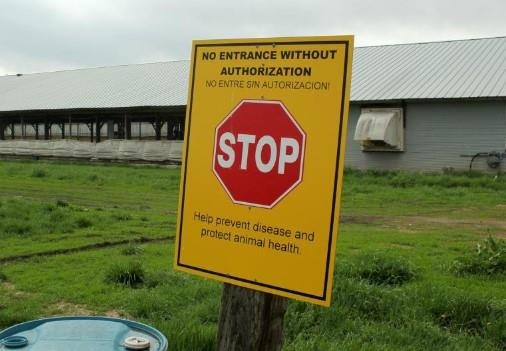
In January 2015, avian influenza, or bird flu, appeared in backyard flocks in Washington state. Within six months, the virus reached 15 states, including Iowa, Nebraska, Minnesota, and Missouri. About 50 million birds died.
Bill Bevans says each day on his farm near Waverly in eastern Nebraska started with a pit in his stomach.
“Kind of the feeling of living under a shadow of potential doom,” Bevans says, of watching the news during the 2015 outbreak. “Every time you open the door to your barn you take a sigh of relief when everybody’s still happy and healthy.”
Bird flu never did bring doom to Bevans’ farm and this time he feels confident his flock of nearly a million chickens and turkeys each year is safe. On a gravel road outside a long, steel turkey barn, Bevans shows off new biosecurity measures, the rules meant to keep the birds healthy. The first layer of protection: keep uninvited visitors and uninvited germs off the farm.
“First thing you see is the stop sign,” Bevans says. “That just lets them know that we’d prefer if they stay back.”
Joan Schrader, Bevan’s sister and the farm veterinarian, says each barn has a second layer of protection: a bench and containers of chlorine powder blocking the entryway, reminding workers to stop, change their boots and disinfect them before they go in and before they go out.
“That way you create a little island of that house and that flock by doing the boot change and the disinfectant going in and out of the house,” Schrader says.
Those kinds of biosecurity measures are not necessarily new, but on poultry farms throughout the Midwest they have taken on new significance in the wake of the 2015 outbreak. Roger Dudley, who tracks livestock disease as the animal epidemiologist for the Nebraska Department of Agriculture, says biosecurity in 2015 was on many farms often overlooked and flawed.
Now, Dudley says, feed trucks are often sprayed down with disinfectant when they arrive at the farm, workers are forced to change boots and some have to shower and change clothes before they go in.
“Biosecurity has to be everybody,” Dudley says. “It’s the feed truck drivers, the rodent control guys that show up. Everybody has to be involved in biosecurity in order to make it work.
At the same time, state and federal scientists test birds to monitor for illness, both at slaughter and on the farm. If the results show highly pathogenic avian influenza, the response is immediate: both the sick and healthy birds on the farm are euthanized. During the outbreak in 2015, farmers complained about how long it took federal officials to give farmers approval to eliminate their flocks.
“One of the real lessons learned from 2014-2015 is the quicker you can put the birds down the less likely it is to spread,” Dudley says.
While drastic, Dudley and other state regulators say it is necessary to stop the disease from infecting more birds, and to preserve the safety of the human population.
Recent outbreaks of avian influenza have not spread from birds to humans in the U.S., but public health agencies are keeping a close watch. When a strain of H5N2 avian influenza appeared in a poultry flock in Dixon County, Nebraska in 2015, local public health workers kept track of farm employees who may have been exposed. For 10 days they were monitored to see if they developed any flu symptoms like fever, cough, or sore throat. None ever did.
Click here to see more...